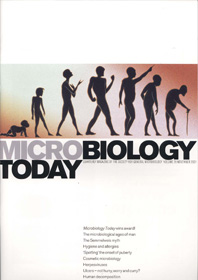Microbes and the Human Body
01 November 2001 publication
The lead articles of the November 2001 issue of Microbiology Today are on the microbiological ages of man; the Semmelweis myth; hygiene and allergies; 'spotting' the onset of puberty; cosmetic microbiology; herpesviruses; ulcers - not hurry, worry and curry?; and human decomposition.
The microbiological ages of man (p. 171)
Throughout our lives, microbes pose a threat to our health and well-being. Roger Finch charts the microbiological ages of man.
Childbed fever - the Semmelweis myth (p. 173)
Was Ignaz Semmelweis really the first to show that puerperal fever is contagious, or is the famous story just a satisfying myth? Milton Wainwright investigates.
Is there a link between hygiene and allergic disorders? (p. 175)
Allergic diseases are increasing rapidly. Is this linked to our rising standards of hygiene? Sundeep Salvi and Stephen Holgate explore the pros and cons of the 'Hygiene Hypothesis'.
Spotting the onset of puberty - the secret's in the skin (p. 178)
Alice returned home from her first day at Grammar School in tears. Mum sat beside her and tried to coax out of the sobbing youngster the cause of her immense distress. After a few minutes, Alice shouted, 'I hate you. No one will make friends with me because I've got spots. Why didn't you take me to the doctors when I asked you to?' One particularly distressing condition affecting the teenage years is acne - Anne Eady and Richard Bojar take a look at our current state of knowledge.
Herpesviruses: from the cradle to the grave (p. 182)
Herpesviruses are prime contenders for inclusion in the microbiological ages of man since they infect humans at all life stages, argues Paul Griffiths.
Cosmetic microbiology (p. 185)
Activities like having a shower, washing our hair or applying deodorant involve the regular use of cosmetics and toiletries. Brian Perry reveals the incessant battle against microbes that has to be waged by manufacturers to make these products safe.
Infectious ulcers: not hurry, worry and curry? (p. 188)
Gastric ulcers were once believed to be caused by lifestyle factors. Dave Kelly desribes Heliobacter pylori, the microbe now known to be the real culprit.
Beyond the grave - understanding human decomposition (p. 190)
Eventually all human lives come to an end. Forensic anthropologist Arpad Vass explains the role of microbes in our bodies after death.
Going Public (p. 200)
Sue Assinder reports on the Developments in Education Award.
Schoolzone (p. 202)
Find out about the services, resources and more that the Society can provide for educational purposes.
Gradline (p. 204)
Tracey Duncombe caught up with some of the Promega Prize contestants at the Society dinner (over a few glasses of wine) to find out their views on the competition and what they felt about career opportunities for PhDs in the UK and abroad.
Comment (p. 228)
Stephen Dealler wonders if we can finally relax about BSE/vCJD.
Cover image credit: David Gifford/Science Photo Library

